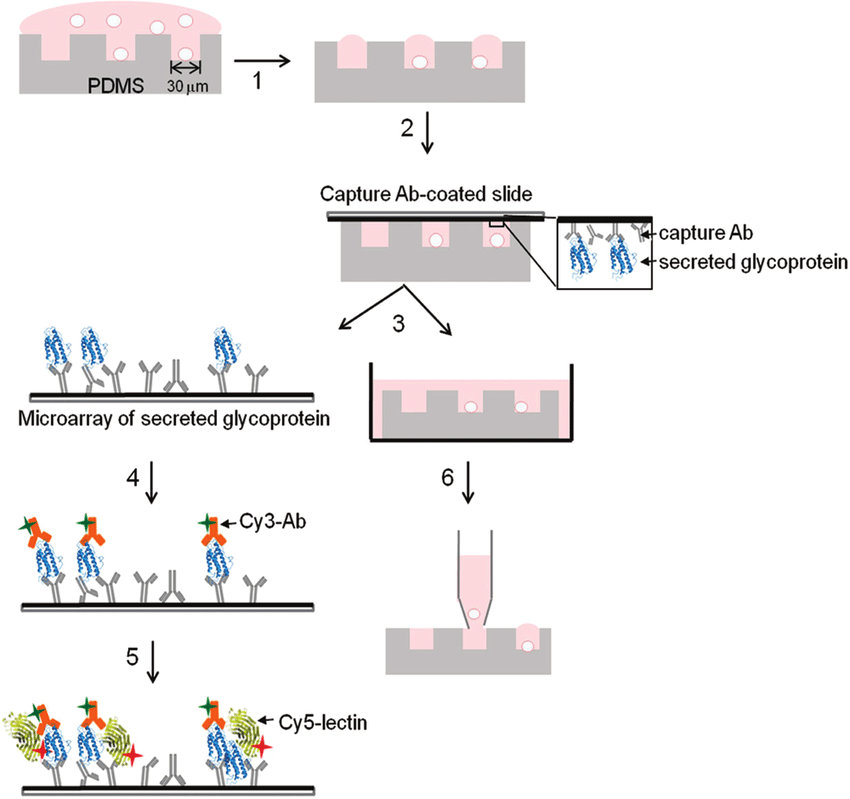Glycoprotein Microarray Service
- Disease-Related Glycoprotein Biomarker Discovery
- Targeted Drug and Antibody Development
- Vaccine Antigen Recognition and Screening
- Molecular Interaction Mechanism Studies
Glycoprotein Microarray Service utilizes high-density microarray technology to immobilize glycoproteins on chip surfaces for the detection of their binding characteristics and functional specificity with molecules such as antibodies, lectins, receptor proteins, or pathogen-associated factors. This service is applicable to antibody screening, glycosylation function analysis, disease-related glycoprotein biomarker identification, and vaccine antigen discovery, providing powerful technical support for research in glycomics, immunology, and translational medicine.
Glycoproteins are widely distributed on the cell membrane, in the extracellular matrix, and in bodily fluids. Their glycosylation modifications play essential regulatory roles in protein folding, localization, stability, and molecular recognition. In various pathological conditions such as cancer, infection, autoimmunity, and neurodegenerative diseases, glycoproteins often undergo significant structural and functional alterations, making them highly valuable as biomarkers and therapeutic targets.
The glycoprotein microarray is a high-throughput analytical platform that immobilizes structurally defined glycoproteins onto a solid-phase chip and detects their interactions with labeled molecules (e.g., antibodies, lectins, receptor proteins, cytokines). This technology enables functional profiling, interaction mapping, and disease relevance assessment of glycoproteins. It combines the multifunctionality of protein microarrays with the specific recognition capacity of glycomics, making it suitable for research in immunology, oncology, infectious biology, and beyond.
MtoZ Biolabs offers Glycoprotein Microarray Service to systematically analyze the interactions between glycoproteins and various recognition molecules, such as antibodies, lectins, receptor proteins, and pathogen factors. This service supports antibody screening, glycosylation-related functional studies, biomarker discovery, and vaccine antigen identification. We offer customizable glycoprotein array design and parallel sample detection to facilitate efficient elucidation of structure-function relationships of glycoproteins and their critical roles in disease mechanisms.

Park S. et al. Anal Chem. 2010.
Figure 1. Schematic of an array-based analysis of glycoproteins secreted by individual cells in microwells.
Analysis Workflow
The main workflow of the Glycoprotein Microarray Service is as follows:
1. Sample Preparation
Glycoproteins are extracted while ensuring structural integrity and stability of glycosylation states.
2. Microarray Chip Construction
Glycoproteins are immobilized onto the chip surface using high-precision spotting techniques to create a high-density, low-background detection platform.
3. Incubation with Recognition Molecules
Labeled recognition molecules (such as antibodies, lectins, or receptor proteins) are incubated with the chip to capture specific glycoprotein-molecule binding events.
4. Signal Detection and Scanning
Fluorescent or enzyme-labeled systems are used for high-resolution scanning to obtain binding signal images and quantitative data.
5. Data Analysis and Reporting
Bioinformatics tools are applied to perform signal normalization, binding profile analysis, and functional annotation, resulting in a comprehensive data report and visualized output.
Service Advantages
High-Throughput Detection: Allows simultaneous analysis of thousands of glycoprotein-recognition molecule interactions on a single chip, significantly improving data acquisition efficiency and enabling large-scale screening studies.
Low Sample Consumption: Requires only nanoliter volumes of each glycoprotein, conserving valuable samples.
Multi-Dimensional Analysis: Enables simultaneous evaluation of recognition specificity, binding affinity, and other parameters within a single experiment.
High Sensitivity: Utilizes highly sensitive detection methods to reliably capture weak molecular interactions.
Customizable Service Support: Offers tailored solutions for glycoprotein selection, array design, and data analysis to meet the specific needs of different research projects.
Sample Submission Suggestions
A variety of sample types are supported. To ensure optimal detection performance, we recommend discussing your experimental objectives and sample background with our technical team prior to submission. A customized sample preparation and shipping guide will be provided.
Applications
Application examples of the Glycoprotein Microarray Service:
Compare glycoprotein binding profiles across different disease states to identify clinically relevant biomarkers for early diagnosis or prognosis.
Identify glycoprotein targets with therapeutic potential to support the development and validation of small-molecule inhibitors or therapeutic antibodies.
Analyze the immunogenic properties of glycoproteins to assist in the design of glycoprotein-based vaccines targeting pathogens or tumors.
Investigate the binding patterns between glycoproteins and receptors, antibodies, or pathogenic factors to elucidate their roles in signaling pathways and immune regulation.
Related Services
How to order?







